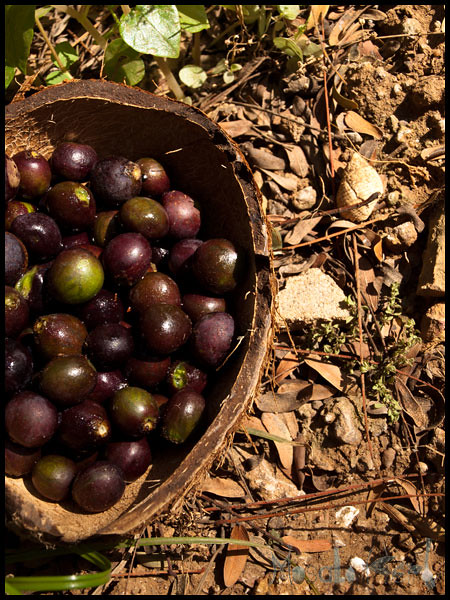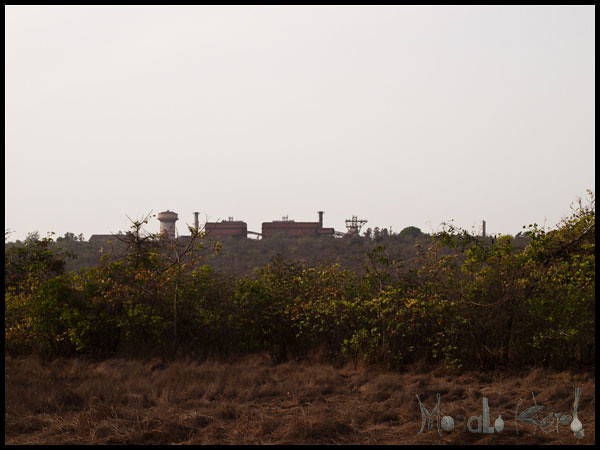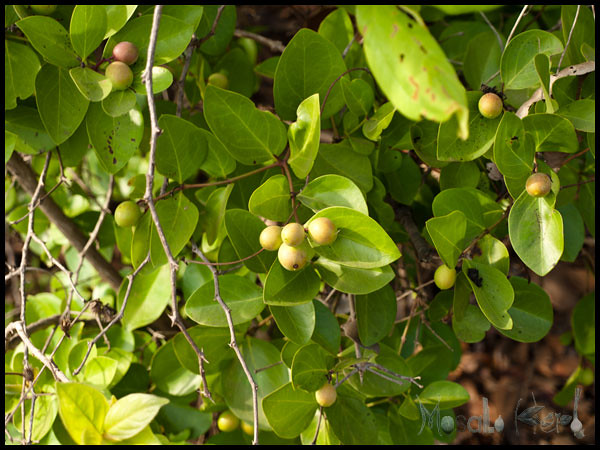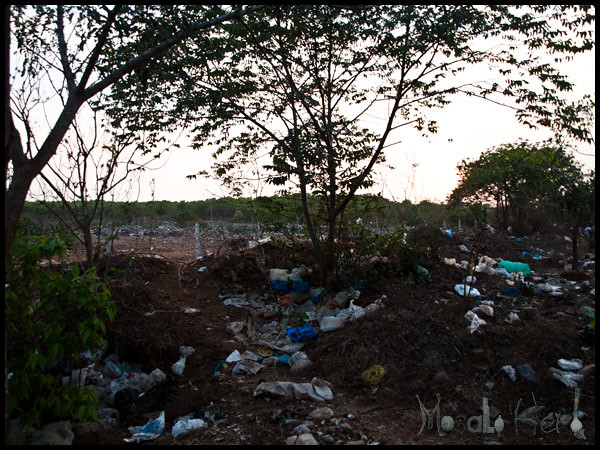I am looking and searching and reading and going crazy with the thought that I won't find the name or any other information about some of the tastiest culinary berries out there.
Those berries are nearly forgotten in between Goas hills, known only by the former generations and the poorer populations of the villages.
It is frustrating to watch a fruit disappear in front of your eyes.
This has been happening since Goas development has taken a sharp commercial turn.
Locals blame the illegal hill cutting, illegal privatization, illegal mining and corrupt goan government for the disappearance of the bio diversity and so of the berries and I have observed it over the past years with a bad stomach feeling, knowing that I can't do anything except make people aware of what they are about to loose.
Imagine, locals are not even allowed anymore to go on their own hills to pick the berries, because some Indian corporations have built 5 star resorts there and trespassing is not allowed!
Maybe educating and sharing the last natural remains will help to preserve my husbands ancestors knowledge.
Who knows, maybe those berries can cure an illness, or maybe they help you with other ailments or they might help to heal wounds!
Even if they don't cure Aids or malaria, the berries are ambrosial and unique!
The internet should actually help to protect and share all the information, but I came across a huge dead end, a lost knowledge.
Imagine, I have been looking for names and information in the past weeks without finding the smallest of hint, except that maybe one of them might be part of the botanical family of Bridelia.
One more Sir has been looking for names online and he had posted photos on flickr (Goa Edgar) here asking for any hints from fellow folks who might be able to identify and provide informations.
The problem too is that the berries are only known to us in the konkani language and konkani is a language which differentiates immensely from village to village.
At least the local's knowledge (or what is left of it) provided a starting point for my research.
Today I am asking here for information about this 3 Berries, in the aim of providing in the future an article for each fruit on Masala Herb and wikipedia.
The names are known to us in konkani (Goan language) in Bardez, Goa (Coastal side).
The Zunna Berry (जुनना)


Global Food Recipes
with Spices and Herbs
Free E-Book available for a limited time. Grab yours now and get instantly inspired!
You missed out!
Jump to:
- The Zunna Berry (जुनना)
- The Kanta berry (कानटा)
- The Zara Berry (जारा)
- If you can help us to preserve the knowledge all around those berries, please don't hesitate to share it with us all. Those berries are very rare and we want to make sure that our descendant will have the chance to experience and use natures goodness in the future!
- 💬 Comments
The Zunna berry is not much bigger then 1 cm in diameter and grows on low bushes.
The raw berry is green and ripens to a white color till it drops and turns a bit transparent.
When it is over ripe the flesh dissolves in your mouth, leaving a small white seed bare.
The flesh is kind of mealy and tastes light sweet, which is incomparable to other fruits in this world.
The fruits ripen around April-May depending on the region and weather situation in Goa.
The Kanta berry (कानटा)

The Kanta berry is the rarest and maybe the most valuable berry of the 3 introduced here today.
It grows on higher bushes around April and May and the fruit has a dimension of 1 inch, with ⅔ of the fruit being flesh (the seed is brown and quite tiny).
This fruit is particularly tricky because you have to be lucky to find a sweet one, but if you do you ll discover that the taste comes close to a cherry's.
One of the berries on the picture has a white sticky substance on the skin, that's some type of fruit glue which the berry emits.
Its extremely sticky!
The Zara Berry (जारा)

The Zara berry is sold by local ladies in April-May in the Mapusa Market, which makes its availability quite common for a few days in those months.
The fruit is 1 cm in dimension, green unripe and the skin ripens purple/black while the flesh and seeds keep their greenish hue.
The fruit is sweet but at times quite sour too, the taste can be compared to the European gooseberries.
One interesting fact of the fruit seed is, that locals keep it to dry in the sun, to crash it afterwards.
Inside that green seed is another smaller beige colored seed which is consumed as delicacy, even the ants were going crazy for the inner seed, carrying the pieces quickly away.
As mentioned above those 3 berries are known under this names in the Bardez Taluka, so names might vary all over Goa and even India.
There are no English names most certainly, so what we are looking for is a botanical name and its nutritional values.
Most surely those berries can be processed to further use in the kitchen.
In Goa it is mostly consumed raw directly from the trees because they don't keep very long and rotten quickly enough.
If you can help us to preserve the knowledge all around those berries, please don't hesitate to share it with us all. Those berries are very rare and we want to make sure that our descendant will have the chance to experience and use natures goodness in the future!
I had promised last week in the zamla/jambul article that I d show you some pictures of the Tiracol fort this week.
Well,... I have decided to postpone that to next week and instead I ll show you where we picked up berries on Goas border hill sides.

This is right at the border to the Indian state of Maharashtra.
To reach there you have to take the ferry, since there is no bridge crossing the river yet.
Well, actually the government is building a bridge right now and once that bridge is up and running, this whole region will be developed and commercialized as well.
You can see the industrial estates in Maharashtra in the back, and right in front some zara berry bushes.

Those are a few zunna berries, there are plenty on those hills.
No soul ever passes over there only once in a while you ll get to see kids and neighbor ladies roaming about the hills to pick up berries and to do their business. ^.^

Further down is the shore, touching the Arabian sea.
Our people come there to go fishing since it is a lovely tranquil spot.

Wild monkey business a 100 feet ahead!
I didn't go any closer because the females started to move and I hadn't come to disturb them... This sight is rare in goa and it was the first time that I had seen wild monkies hanging around like that!!

This photo wasn't taken in Keri but while coming back to the civilization, between mapusa and siolim.
Everybody knows this place here!
It used to be a valley of forests full of nature, now it is a huuuuge dumping place for garbage.
Nowadays at least its a bit better, it used to be soo much worse 2 years back. I remember seeing a horde of vultures around that area, like death taking its rounds...
